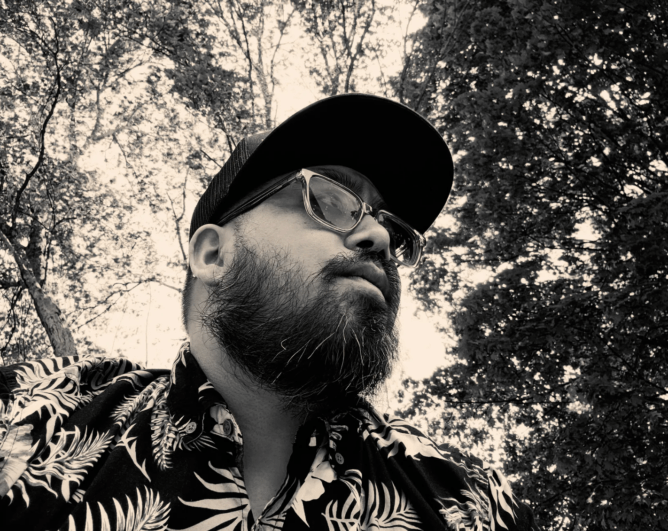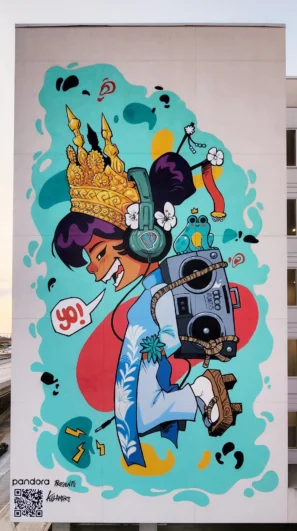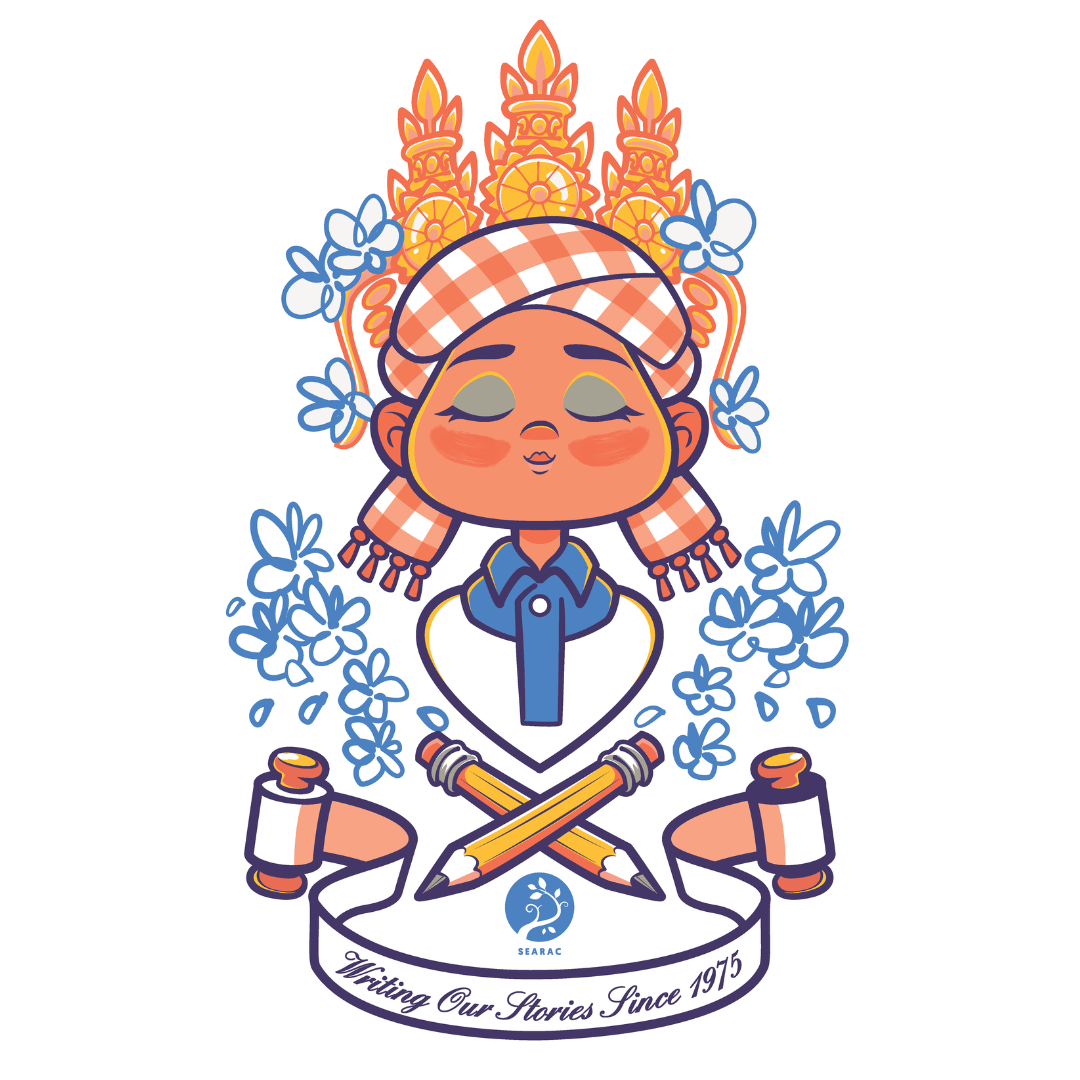Killamari is a freelance illustrator and designer based in Atlanta, GA and specializes in character based illustrations and designs. He likes drawing wacky characters and creating vibrant worlds by mashing together Khmer culture, street art, monsters, martial arts, and yummy eats! When not illustrating, Killamari likes to paint murals, slap stickers, eat pizza, and kick it with his daughters Matilda and Celestine. Learn more about his work at www.killamari.com.
Tell us a little about yourself! Who is your family/community, where are you located, what kind of art do you do?

My name is Killamari, and I’m an Atlanta-based, Asian American artist. My father’s from Cambodia and my mother’s from Vietnam. They both came to the United States in the ’70s and met in Columbus, GA. They moved to Atlanta and started a family, and that’s where I got my roots. I grew up in the northern Virginia area and came back to the South to study illustration. I felt welcomed immediately by the Atlanta art scene and the community here.
My artistic journey started when I was a kid. Like most kids, I loved to draw, but I was lucky enough to never let that part of myself go. My style is inspired by Saturday morning cartoons, comic books, and the graffiti I would pass walking home from school. I like this particular style because there’s always cool line work and bold colors. These days, I am focused on doing murals and prefer working with spray paint because it’s fun and can handle the different elements. I love working with spray paint, but am also open to creating with everything — really anything I can get my hands on! As long as I’m making something, I’m having fun.
What does the 50th anniversary of Southeast Asian American refugee resettlement mean to you?

It’s a celebration of the beginning of my family’s story here in the United States. My parents came here in the mid-70s to flee war. And that’s always a common story when you speak to Southeast Asian people — it’s typically some kind of war story. The positive side of this is that families started new stories over here and found new pathways to a future away from tragedy. While I was getting my master’s degree, I had the chance to go to Cambodia and actually met my wife over there. I was working on my thesis, and that trip allowed me to get in touch with my roots as I was heavily influenced in learning who I was and my heritage. People who are familiar with Southeast Asia might know about the Vietnam War and the Killing Fields, but I also wanted to touch on the things that no one talks about, like the clothing, the music, and the food.
What organization are you supporting with this fundraiser, and why does their work speak to you?
I chose the Asian American Advocacy Fund in Atlanta. They are great at shedding light on the Asian community here. I have worked on a coloring book project with them, as well as painting and designing denim jackets that shared imagery of the diverse stories of our heritage. I’ve really enjoyed being able to find fun ways for people to connect with us and our stories because when you think of the South, you may not think about Asian people living down here. Our stories and our presence can seem like a small force within the Atlanta scene, but you can see our impact along Buford Highway, where Asian American and especially Southeast Asian restaurants and cultural enclaves exist.
What do you hope for Southeast Asian American communities for the next 50 years?
For me, it’s important to be seen, especially now as a parent of two kids. I have a 3-year-old and a 6-year-old, and in order for them to grow up and feel like a part of the fabric of this community, it’s important for them to be able to see their faces. I didn’t see a lot of Southeast Asian people represented in artwork, so I try to do that when I do get the opportunity to paint something. I have a mural here in Atlanta, and it’s on a six story building. It’s an image of a female with a boombox stuck to her back, but she’s got the traditional makuṭa, which is a very tall gold crown that some Southeast Asian cultures have, and she’s also wearing a Vietnamese ao dai with Japanese sandals and some Hawaiian bracelets. When I take my daughter to see the mural, she thinks it’s her. She’ll tell me, “Oh, that’s me! My dad painted me on that building.” And in a way it is right because I’m trying to represent who we are.
What do you want the world to know about Southeast Asian American refugee communities?
I was watching this interview of a Khmer artist from California, and she shared how she felt a responsibility to be seen as much as possible. As artists, we may forget that people see themselves in us through the artwork that we create. It’s a reminder of the responsibility to be as present as possible, because someone is going to see it and relate to it and possibly realize that they can also do something similar. And it doesn’t necessarily have to be art. Whatever it is you’re into, just do it and do it in a big way so that other people from the next generation can see it and be inspired by it.

Statement about the fundraiser piece: This design is about having the opportunity to continue to write our stories by resettling here. My parents came to the United States in the ’70s from Cambodia and Vietnam. I am thankful that they were given a chance to have lives here when things were so bad over there. Their sacrifice and journey has led to me having a life, a community, and now my children.
You can find t-shirts and tote bags with Killamari’s designs on our Bonfire store AND new for this year, find stickers, posters, magnets, prints, and notebooks on our Redbubble.
Check out additional 50th Anniversary Fundraiser interviews with our artists here:
Holding onto culture through art with HNin Nie
Celebrating SEAA courage and bravery with Sheena Vang
Khou Vue is celebrating SEAA perseverance
Kat Eng is finding the words for what it means to be free
Being outspoken about SEAA heritage with Timothy Singratsomboune
